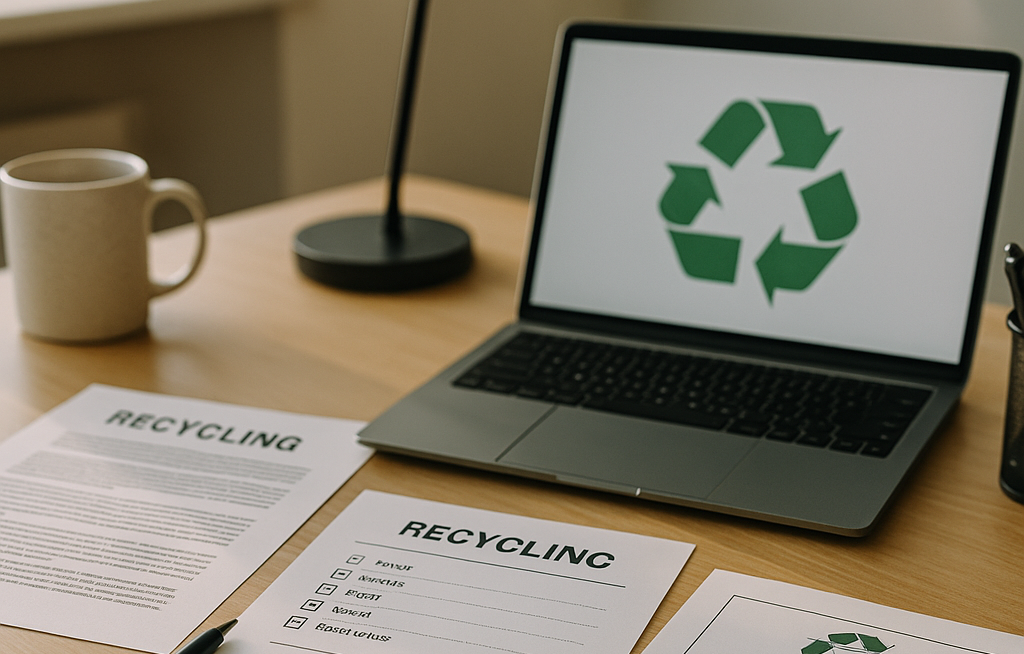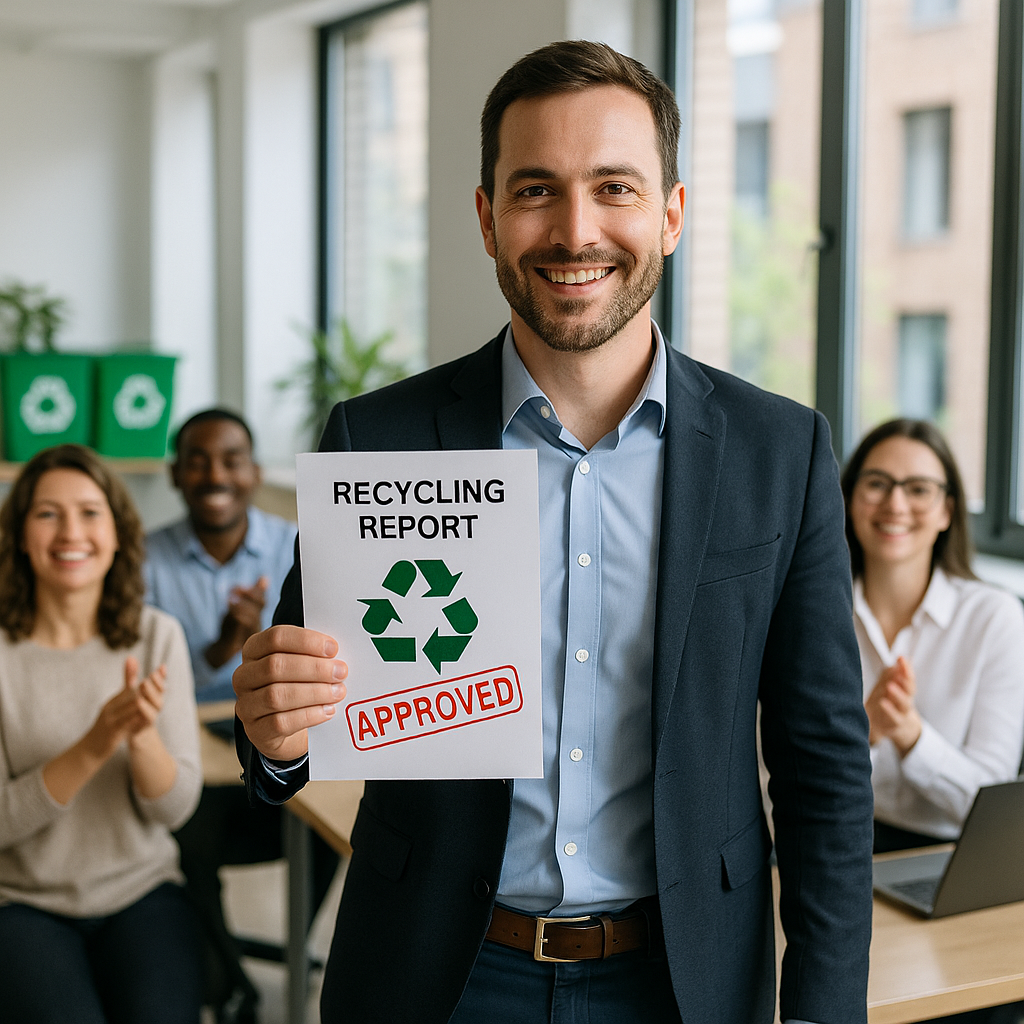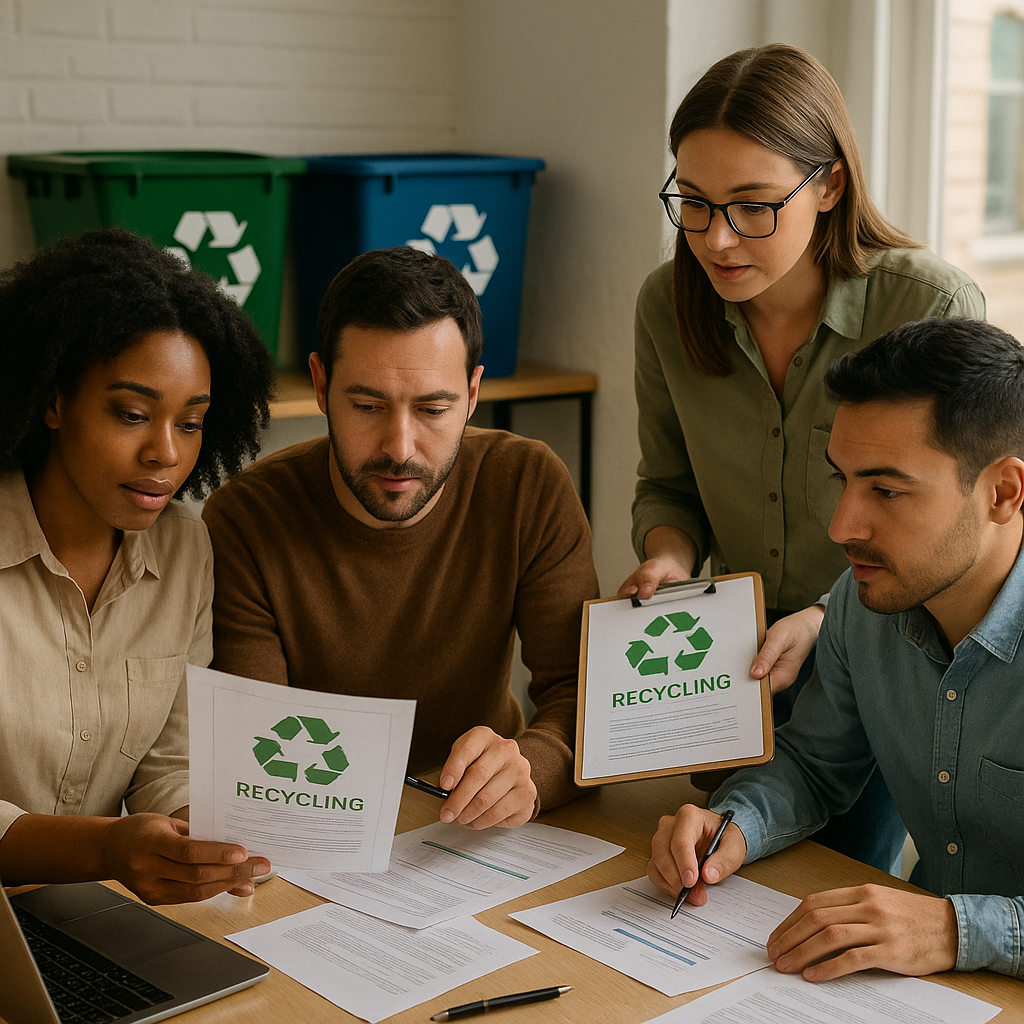5901 Botham Jean Blvd, Dallas, TX 75215
What is Downstream Recycling Documentation for Corporate Audits?
August 1, 2025As environmental consciousness grows within the business sector, companies face increasing pressure to verify their waste management practices. Downstream recycling documentation acts as a paper trail that tracks recyclable materials after they depart from a facility. This critical documentation verifies responsible handling of materials through each step of the recycling chain—from collection to processing and final disposition.
Corporate environmental audits rely heavily on these records to assess compliance with regulations and sustainability commitments. Without proper documentation, businesses cannot prove their recycling claims or verify that materials avoided landfills. This gap creates significant liability risks, as companies remain legally responsible for their waste even after it leaves their premises.
The documentation acts as a protective shield against regulatory penalties and reputational damage. For sustainability-focused organizations, these records provide the evidence needed to support environmental certifications, ESG reporting, and zero-waste initiatives that are increasingly important to stakeholders and consumers alike.
What are the Key Components of Downstream Recycling Documentation?

Proper documentation forms the backbone of responsible downstream recycling management. These records provide traceability throughout the recycling chain and ensure accountability for all materials processed. Effective documentation is not just a regulatory requirement but is also critical for environmental protection and risk management.
Material tracking documentation serves as evidence of proper handling and creates a verifiable chain of custody from collection to final disposition. Without thorough documentation, companies face significant compliance risks and potential penalties under frameworks like the R2 Standard and other waste management regulations.
Material Tracking Records
The foundation of downstream recycling documentation is comprehensive material tracking. Companies must maintain detailed records that include:
- Complete inventory of all recyclable materials sent downstream
- Precise material types and categories (e.g., metals, plastics, electronics, focus materials)
- Exact quantities by weight or unit count
- Shipment dates and transportation details
- Receiving facility information and confirmation receipts
These records should be organized chronologically and retained for at least three years, though many certification programs require longer retention periods. Digital tracking systems have increasingly replaced paper documentation, allowing for real-time monitoring and more efficient reporting.
Downstream Vendor Due Diligence
Companies must thoroughly vet all downstream vendors through documented due diligence processes. Key components include:
- Initial qualification audits to verify vendor capabilities
- Documentation of each vendor’s certification status (R2, e-Stewards, etc.)
- Regular performance evaluations and ongoing monitoring
- Records of site visits and facility inspections
- Verification of proper permits and regulatory compliance
The R2 Standard specifically requires conducting initial due diligence audits of each downstream vendor to verify their conformance with responsible recycling requirements. These audits must be documented and available for review during certification assessments.
Compliance Verification Documentation
Ensuring downstream vendors comply with all applicable regulations requires specific documentation:
- Verification of each vendor’s environmental permits and licenses
- Records of compliance with local, state, and federal regulations
- Documentation of proper handling procedures for hazardous materials
- Environmental health and safety compliance records
- Evidence of proper worker safety protocols
When non-compliance issues are identified, documentation must include corrective action plans, implementation timelines, and follow-up verification. This creates accountability throughout the recycling chain and demonstrates due diligence in addressing compliance gaps.
Written Agreements and Contracts
Formal agreements between recycling partners form a critical part of downstream documentation:
- Detailed service agreements specifying handling requirements
- Material specification sheets outlining acceptance criteria
- Contractual terms regarding regulatory compliance responsibilities
- Data security and destruction requirements where applicable
- Environmental performance standards and expectations
These agreements should clearly outline responsibilities, liabilities, and expectations for both parties. They provide legal protection and ensure all partners understand their obligations in maintaining compliant operations throughout the recycling chain.
For electronic waste specifically, agreements should address proper handling of Focus Materials (FMs) as defined in the R2 Standard, including batteries, circuit boards, and mercury-containing devices. This documentation is essential for demonstrating responsible management of potentially hazardous components.
| Certification Type | Documentation Requirement |
|---|---|
| ISO 9001 | Documents and records reporting internal processes and procedures |
| R2 Standard | Initial due diligence audits, vendor certification status documentation, compliance verification for hazardous materials |
| e-Stewards | Due diligence documentation, performance evaluations, regulatory compliance verification |
Certificates and Final Disposition Documentation
The final component of downstream documentation includes verification of proper recycling and final disposition:
- Certificates of recycling for all processed materials
- Material recovery reports showing recycling rates
- Final disposition documentation for all waste streams
- Mass balance records tracking materials through the recycling chain
- Destruction certificates for data-bearing devices where applicable
This documentation closes the loop in the recycling chain and provides evidence that materials were properly processed according to all applicable standards and regulations. It also supports sustainability reporting and demonstrates commitment to circular economy principles.
How are Downstream Recycling Audits Conducted?

Downstream recycling audits are systematic evaluations conducted to verify that materials are properly managed throughout the recycling chain. These audits ensure compliance with environmental regulations and industry standards while minimizing potential liabilities for waste generators.
Documentation Review
The first step in a downstream audit involves examining essential documentation. Auditors verify that recycling facilities possess all necessary licenses and permits required for their operations. Without proper licensing, the audit cannot proceed.
Auditors then review inventory records, including manifests of recyclable waste received, stock inventories, and resource sales accounts. This documentation helps establish a paper trail for all materials handled by the facility and ensures proper tracking from receipt to final disposition.
Facility Inspection
Physical inspection forms the core of a downstream audit. Auditors conduct thorough walk-throughs of recycling facilities to assess compliance with environmental and safety standards. They examine operational practices, housekeeping conditions, and equipment requirements.
During these inspections, auditors verify that appropriate environmental safeguards are in place. This includes checking containment systems, emissions controls, and proper storage of hazardous materials. Safety measures such as emergency response equipment, personal protective equipment usage, and hazard communication systems are also evaluated.
Material Handling Verification
A critical component of downstream audits is verifying the proper handling of materials. Auditors trace the path of recyclables from receipt through processing to ensure compliance with proper procedures.
This verification includes examining how materials are sorted, processed, and prepared for recycling. Auditors check that hazardous components are safely removed and managed according to regulations. They also verify that materials designated for specific recycling processes actually undergo those processes rather than being landfilled or exported improperly.
For electronic waste specifically, auditors ensure compliance with requirements such as data destruction protocols and proper management of hazardous components.
Mass Balance Assessment
Verifying the mass balance of recyclable items is essential to confirm that materials are being recycled as claimed. Auditors track quantities of materials entering the facility against the amounts of recycled commodities and residuals exiting the facility.
This assessment involves weighing incoming and outgoing materials, reviewing processing records, and ensuring that the quantities match expected recovery rates. Mass balance verification helps prevent situations where recyclables might be diverted to landfills or other improper disposal methods instead of actually being recycled.
| Documentation Review | Examine essential documentation, verify licenses, review inventory records |
| Facility Inspection | Thorough walk-throughs to assess compliance with environmental and safety standards |
| Material Handling Verification | Trace recyclables from receipt through processing to ensure proper procedures |
| Mass Balance Assessment | Verify mass balance to confirm claims of recycling |
| Downstream Vendor Assessment | Evaluate vendor management practices, contracts, audits, and tracking |
| Follow-Up and Monitoring | Regular audits, corrective action plans, and implementation of corrective actions |
Downstream Vendor Assessment
Auditors also evaluate the recycling facility’s own downstream vendor management practices. They verify that the facility conducts appropriate due diligence on any vendors they send materials to for further processing.
This assessment includes reviewing contracts with downstream vendors, examining audit reports conducted on those vendors, and confirming proper tracking of materials sent to these facilities. The goal is to ensure responsibility throughout the entire recycling chain, not just at the immediate facility being audited.
Follow-Up and Monitoring
Comprehensive downstream auditing programs include regular monitoring and follow-up audits. If violations or non-conformances are identified, auditors document these issues and establish corrective action plans with specific timelines.
Follow-up inspections verify that corrective actions have been implemented effectively. This ongoing monitoring helps ensure continuous compliance and improvement in recycling practices over time rather than a one-time assessment.
By systematically examining documentation, inspecting facilities, verifying material handling, assessing mass balance, evaluating downstream vendors, and conducting regular follow-ups, downstream recycling audits ensure that recyclable materials are managed responsibly throughout the recycling chain.
What are the Benefits of Thorough Downstream Recycling Documentation?

Comprehensive downstream recycling documentation offers substantial advantages that extend beyond merely meeting regulatory requirements. For organizations handling electronic waste and other recyclable materials, proper documentation serves as both protection and a strategic asset in today’s sustainability-focused business environment.
Ensuring Regulatory Compliance
Thorough documentation provides verifiable proof that your organization complies with all applicable recycling regulations. With environmental legislation becoming increasingly stringent across jurisdictions, proper documentation helps you confidently navigate complex compliance requirements. The documentation trail demonstrates that materials were handled according to legal standards, eliminating guesswork during audits or regulatory inspections.
Companies that maintain detailed records of their downstream recycling activities can easily demonstrate compliance with regulations like the Resource Conservation and Recovery Act (RCRA) or state-specific Extended Producer Responsibility (EPR) laws. This proactive approach significantly reduces the risk of costly penalties and enforcement actions.
Mitigating Liability Risks
When recyclable materials leave your facility, liability doesn’t necessarily end. Without proper documentation showing where materials went and how they were processed, your organization remains vulnerable to potential legal and reputational consequences if those materials are mishandled downstream.
Comprehensive tracking that follows materials through their entire recycling journey creates a robust chain-of-custody record. This documentation provides crucial protection against future claims and helps establish that you exercised due diligence in selecting qualified recycling partners.
Supporting Sustainability Goals and Reporting
Organizations with sustainability commitments need solid data to measure progress. Downstream recycling documentation offers exactly that—quantifiable metrics that demonstrate environmental impact reduction. This information is invaluable for:
- Tracking progress toward specific sustainability targets
- Completing ESG (Environmental, Social, Governance) reports
- Responding to stakeholder inquiries about environmental practices
- Qualifying for sustainability certifications and recognition
The data from thorough documentation enables accurate calculation of landfill diversion rates, greenhouse gas emissions avoided, and materials recovered. These metrics transform abstract sustainability goals into concrete achievements that can be communicated to stakeholders.
Realizing Cost Savings
Beyond compliance and reputation benefits, detailed recycling documentation often reveals opportunities for operational cost savings. By tracking what materials are being recycled and in what volumes, organizations can:
- Identify waste streams that could be reduced at source
- Optimize collection schedules and container sizes
- Negotiate better terms with recycling vendors based on accurate volume data
- Potentially generate revenue from valuable recyclable materials
This level of insight transforms waste management from a cost center into a strategic business function that contributes to both environmental and financial goals.
Enhancing Brand Reputation
Today’s consumers, investors, and business partners increasingly favor organizations with demonstrated environmental responsibility. Thorough documentation allows you to substantiate environmental claims with verified data, building trust with key stakeholders.
When backed by solid documentation, your sustainability achievements can be confidently featured in marketing materials, annual reports, and public communications. This transparency strengthens your brand’s environmental credentials and helps differentiate your organization in competitive markets.
Preventing Improper Waste Exports
One of the most significant ethical concerns in recycling is the potential for electronic waste to be improperly exported to developing countries, where it may be processed in ways harmful to both people and the environment. Comprehensive documentation helps prevent this by creating accountability throughout the recycling chain.
By tracking materials to their final processing destination, organizations can verify that their waste is handled ethically and in compliance with international agreements like the Basel Convention, which governs the transboundary movement of hazardous wastes.
Future-Proofing Your Recycling Program
The regulatory landscape for waste management continues to evolve, with new requirements emerging regularly. Organizations with robust documentation systems in place are better positioned to adapt to these changes without significant disruptions or additional costs.
Detailed historical records also provide valuable baseline data against which to measure the impact of program changes or new initiatives, enabling continuous improvement in recycling performance over time.
Implementing thorough downstream recycling documentation isn’t just about avoiding problems—it’s about creating a foundation for more sustainable, efficient, and responsible waste management practices that benefit both your organization and the environment.
Conclusion: Implementing Effective Downstream Recycling Documentation

Implementing robust downstream recycling documentation is essential for responsible corporate environmental stewardship. This documentation not only serves as proof of compliance with increasingly stringent regulations but also demonstrates your commitment to sustainability. Comprehensive record-keeping systems that track materials from collection to final processing provide companies with visibility into their entire recycling chain.
Successful organizations integrate documentation practices into their operations by establishing clear tracking systems, conducting regular vendor audits, and cultivating strong relationships with certified recycling partners. These practices protect companies from potential liability issues and position them as leaders in environmental responsibility. By verifying that recyclable materials are properly handled throughout the downstream process, businesses contribute meaningfully to resource conservation and waste reduction efforts.
For assistance in implementing effective downstream recycling documentation systems that meet your specific compliance needs, contact Okon Recycling at 214-717-4083.
